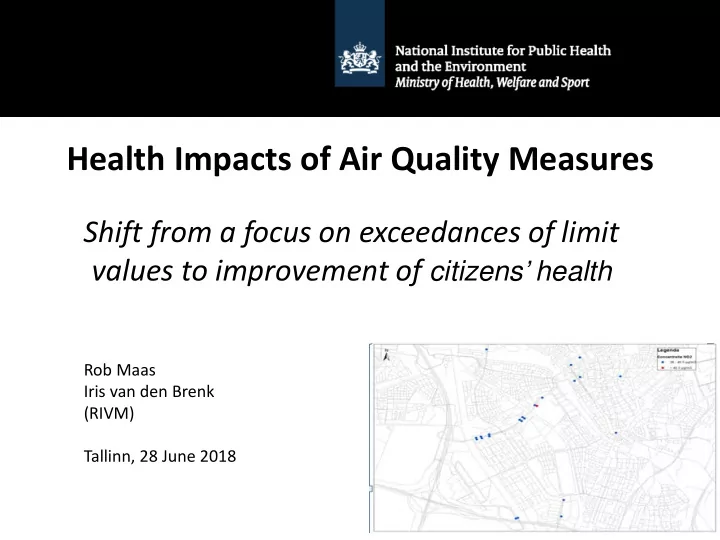

Health Impacts of Air Quality Measures Shift from a focus on exceedances of limit values to improvement of citizens’ health Rob Maas Iris van den Brenk (RIVM) Tallinn, 28 June 2018
From concentrations to health impacts air pollution Local data population concentration concentration- exposure estimate WHO/HRAPIE response function background data (mortality rate, Local data morbidity rate,..) impact estimates
General health impact approach Relative Risk: RR = relative risk (of mortality or morbidity) associated with a level of exposure (e.g 1.06 per 10 µg/m 3 PM2.5) Population Attributable Fraction: PAF = [p × (RR – 1 )] ⁄ [p × (RR – 1) + 1] p = proportion of people exposed certain exposure levels Attributable mortality or morbidity: N = PAF × total mortality or morbidity
Choice of indicators • Premature deaths (N) • YLL = N * LLE • YLD • DALY • ∆ LLE
Morbidity YLD = Incidence x Disability Weight x Length of period until death or recovery Health impacts Unit Disabilty Weight Monetary damage per unit per unit Days with bronchitis in children (age 6-12 Days/year 0.00062 € 49 years) Incidence of asthma symptoms in asthmatic Days/year 0.00019 € 49 children (age 5-19 years) Incidence chronic bronchitis in adults (age Number/year 0.99 € 62712 18+ years) Hospitalizations, cardiovascular diseases, all Number/year € 2574 0.02255 ages Hospitalizations, respiratory diseases, all Number/year € 2574 0.01565 ages Restricted activity days (RADs) Days/year 0.00027 € 108 Work days lost, population 20-65 years Days/year 0.00027 € 152 Years of Life Lost (YLL) Number/year 1 € 67500
Which tools are available? Tools for local assessments: • AIR-Q+ • HRAPIE-based variants • APHEKOM total and cardiovascular mortality & hospitalization (RRs 2004/2005) • HEAT cost-benefit assessment of walking and cycling National health impact estimates by: IIASA-GAINS, EMRC, EEA/ETC-ACM, JRC-FASST, OECD, WHO
AIR-Q+ Average YLL per case of premature death: ~ 10 Total YLL: 900 (10 ug/m3) – 3430 (25 ug/m3)
HRAPIE-based tool (GGD-RIVM) Utrecht 2015 (343.000 inhabitants) Concentration PM10 in µg/m³) 15,80 Concentration PM2.5 in µg/m³ 12,40 • Concentration NO2 in µg/m³ 25,20 Cases / Burden of Morbidity Share of disease burden Disease Due to PM10: Annual number of days with bronchitis in children (age 6-12 years) 2371 8,0% Incidence chronic bronchitis in adults (age 18+ years) 120 11,3% Incidence of asthma symptoms in asthmatic children (age 5-19 years) 5315 2,9% Due to PM2.5: Hospitalizations, cardiovascular diseases 52 0,9% Hospitalizations, respiratory diseases 50 1,8% Restricted activity days (RADs) (including sick-leave, hospital admission, symptom days) 289803 4,4% Work days lost, working age population (age 20-65 years) 90440 4,4% Lung cancer (age 30+ years) 14 8,2% Low birth weight (< 2500 g at term) 33 15,8% Total YLD: 152 Mortality Cases of post-neonatal mortality (age 1-12 months) due to PM10 0,1 4,1% Cases of premature deaths due to PM2.5 (RR = 1,06; Co = 2.5) 106 5,8% Cases of premature deaths due to NO2 (RR = 1,02; Co = 5) 72 3,9% Total YLL: 1840 Decline in average life expectancy in days 208 (6.9 months) Due to PM2,5 139 (4.5 months) Due to NO2
Uncertainties in assessing health impacts of measures • Cut-off level (Co) • Direct NO 2 impacts (additional to PM2.5 and ozone) – WHO/HRAPIE (2013): RR = 1.055 – RW Atkinson (July 2018): RR = 1.02 • Double counting NO 2 and PM2.5 • Effectiveness of measures (“Source apportionment”)
NO 2 : HRAPIE: RR = 1.055 per 10 ug/m3 and Co = 20 ug/m3 but: impacts also at lower concentrations and double counting 6000 5000 4000 YLL/1000 1.5 3000 10 20 2000 1000 0 1.055 1.039 1.027 Sensitivity analysis EEA/ETC ACM
Which pollutant to blame? mid - 6.4 M Yll low - 3.8 M YLL high - 7.1M YLL PM2.5 PM2.5 NO2 NO2 O3 O3 Co/RR high mid low GGD/RIVM PM2.5 2.5/1.062 2.5 /1.062 5/1.062 2.5/1.06 NO2 10/1.055 10/1.039 20/1.039 5/1.02 O3 somo10 somo10 somo35 somo35
Which measures to take?
Health impact assessment of policy measures a) 100% EV b) LEZ Air quality and health impact of measures for Utrecht or Inner City Utrecht 2015 100% EV LEZ Inner city 100% EV LEZ ug/m3 NO2 25,2 12,6 22,7 28,8 21,6 27,4 PM10 15,8 14,9 15,3 20,8 20,2 20,2 PM2,5 12,4 11,7 12,0 13,0 12,6 12,6 Cases of premature death PM2.5 106 -7 -4 6 -0 -0 NO2 72 -44 -9 4 -1 -0 Average loss in life expectancy (days) PM2.5 208 -15 -8 221 -8 -8 NO2 139 -87 -17 164 -50 -10 Days with bronchitis (children) 2371 -190 -105 408 -15 -15 Local measures give more NO2 benefits than PM2.5 benefits • Full electric gives more health benefits than banning old diesel vehicles in a LEZ • A larger LEZ is more effective •
Take home messages • No safe concentrations • Health impact indicators are interrelated: which indicator is preferred depends on target audience • NO 2 can effectively be influenced by local policy • Be aware of assumptions and uncertainties in calculations sensitivity analyses needed for robust policy advice
Recommend
More recommend